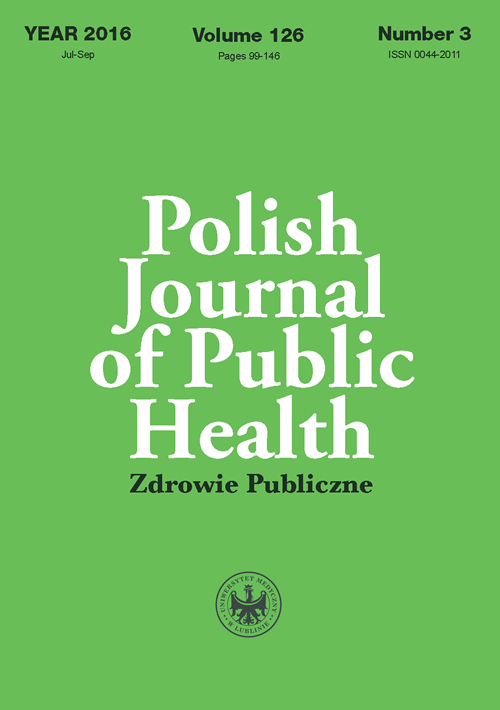Caries prevention programs for children based on the current health care system in Poland
DOI:
https://doi.org/10.1515/pjph-2016-0030Keywords:
dental caries, dental prophylaxis, health careAbstract
Prevention is the most effective element of measures to promote oral health. The authors have conducted an analysis of the current health system in Poland with particular emphasis put on caries prevention focused on children. It is worth noting that in the first days of life a midwife introduces „the area of dental prophylaxis”. In subsequent years of life i.e. 2, 4, 6, 10, 13, 16, 19, both the dentist and the primary care doctor provide prophylactic services. More preventive actions are organized in primary school (grades I-VI), where group fluoride prophylaxis and education in oral health are carried out by a nurse/school hygienist. The effects of preventive measures, as measured by epidemiological studies presented among others in the reports from the Monitoring of Oral Health by the Ministry of Health, show that the adopted regulations are unsatisfactory.
It is necessary to carry out a public information campaign on the negative consequences of neglecting disease prevention and the consequences of incorrect early treatment of oral cavity diseases and their influence over the proper development of children.
References
1. Petersen PE. Improvement of global oral health – the leadership role of the WHO. Comm Dent Health.2010;27:194-9.
2. Hobdell M, Petersen PE, Clarkson J, Johnson N. Global Goals for oral health 2020. Int Dent J. 2003;53:285-8.
3. Petersen PE, Kwan S. The 7th WHO Global Conference on Health Promotion – towards integration of oral health. Comm Dent Health. 2010;27(Suppl. 1):129-36.
4. Wierzbicka M, Szatko F, Strużycka I, et al. Monitoring Zdrowia Jamy Ustnej 2012. Stan zdrowia jamy ustnej i jego uwarunkowania oraz potrzeby profilaktyczno-lecznicze dzieci w wieku 6 i 12 lat oraz młodzieży w wieku 18 lat. Warszawa: WUM; 2012.
5. Wierzbicka M (red.), Szatko F, Strużycka I, et al. Stan zdrowia jamy ustnej i jego uwarunkowania oraz potrzeby profilaktyczno-lecznicze dzieci w wieku 5, 7 i 15 lat. Warszawa: WUM; 2011.
6. Jodkowska E, Wierzbicka M, Strużycka I, Rusyan E. Polish public programme of dental caries prevention in children aged 6, 12 and 18 years in 2012. Przegl Epidemiol. 2014;68(1):45-52, 133-7.
7. Jańczuk Z. Profesjonalna profilaktyka w stomatologii. Warszawa: PZWL; 2004.
8. Rozporządzenie Ministra Zdrowia z dnia 6 listopada 2013 r. w sprawie świadczeń gwarantowanych z zakresu leczenia stomatologicznego. Regulation of the Minister of Health of 6th November 2013 on guaranteed benefits in the field of dental treatment, by PHC doctor in accordance with the Regulation of the Minister of Health of 24th September 2013 on guaranteed benefits in the primary health care (Annex 1; Annex 4)].
9. Rozporządzenie Ministra Zdrowia z dnia 28 sierpnia 2009 r. w sprawie organizacji profilaktycznej opieki zdrowotnej nad dziećmi i młodzieżą (Dz. U. Nr 139, poz. 1133).
10. [http://www.mz.gov.pl/]
11. [https://www.nfz.gov.pl/]
12. [http://www.aotm.gov.pl]
13. Monitorowanie zdrowia jamy ustnej populacji polskiej program na lata 2016-2020. Podstawa prawna: art. 48 ust. 1 ustawy z dnia 27 sierpnia 2004 r. o świadczeniach opieki zdrowotnej finansowanych ze środków publicz-nych (Dz. U. z 2015 r. poz. 581) Warszawa, 2015 r.
14. Rozporządzenie Rady Ministrów z dnia 4 sierpnia 2016 r. w sprawie Narodowego Programu Zdrowia na lata 2016-2020.
15. [www.acff.pl]
16. Bachanek T. (red.) Monitorowanie stanu zdrowia jamy ustnej populacji polskiej w latach 2013-2015. Lublin, 2014.
Downloads
Published
Issue
Section
License
Copyright (c) 2016 Polish Journal of Public Health

This work is licensed under a Creative Commons Attribution-NonCommercial-NoDerivatives 3.0 Unported License.


